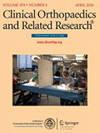Is Kinesiophobia Associated With Quality of Life, Level of Physical Activity, and Function in Older Adults With Knee Osteoarthritis?
IF 4.2
2区 医学
Q1 ORTHOPEDICS
引用次数: 0
Abstract
BACKGROUND Beyond knee pain itself, the fear of movement, also known as kinesiophobia, recently has been proposed as a potential factor contributing to disability and functional limitation in patients with knee osteoarthritis (OA). Nevertheless, the available evidence on the association of kinesiophobia with patient-reported outcome measures (PROMs) in knee OA remains limited. QUESTIONS/PURPOSES Among patients with nonoperatively treated knee OA, we asked: (1) Is kinesiophobia associated with decreased quality of life (QoL), functional outcomes, and physical activity? (2) What are the patient disease and psychosocial demographic factors associated with kinesiophobia? METHODS This was a multicenter, cross-sectional study of 406 general orthopaedic patients from two urban, referral-based tertiary hospitals in Singapore under a single healthcare group who received nonoperative treatment for knee OA. Between July 2020 and January 2022, a total of 1541 patients were treated for knee OA nonoperatively. Based on that, 60% (923) of patients were rejected due to refusal to participate in the study, 3% (52) of patients were enrolled but did not show up for their appointments for data collection, and a further 10% (160) had incomplete data sets, leaving 26% (406) for this study's analysis. The mean age of patients was 64 ± 8 years, 69% were women, and 81% were Chinese. The level of kinesiophobia in patients was measured using the Brief Fear of Movement scale, a validated 6-item questionnaire ranging from a score of 6 to 24 to measure kinesiophobia in OA, with higher scores representing higher levels of kinesiophobia. In terms of PROMs, the QoL and functional level of patients were measured using the QoL and activities of daily living (ADL) components of the widely validated 12-item Knee Injury and Osteoarthritis Outcome Score (KOOS-12). The KOOS-12 is a questionnaire consisting of 12 items encompassing three domains (QoL, ADL, and pain), with each item ranging from 0 to 4 and higher scores representing worse outcomes. The University of California, Los Angeles (UCLA) Activity Scale was used to measure the level of physical activity in patients. The UCLA score is a descriptive 10-level activity scale ranging from a score of 1 to 10, with higher scores representing greater physical activity levels. A directed acyclic graph, which is a relationship map used to depict and visualize the confounders between the studied variables, was used to identify the confounders between kinesiophobia and PROMs (QoL, function, and physical activity). An ordinal regression model was used to explore: (1) the association between kinesiophobia (as measured using the Brief Fear of Movement scale) and PROMs (as measured using KOOS QoL, KOOS ADL, and the UCLA Activity Scale), adjusting for key confounders such as age, gender, pain, side of arthritis, OA duration/severity, and psychosocial factors (for example, depression, anxiety, and education levels), and (2) the association between kinesiophobia (Brief Fear of Movement scale) and various patient disease and psychosocial demographic factors. RESULTS After accounting for confounders, greater kinesiophobia (higher Brief Fear of Movement scores) was associated with lower QoL (KOOS QoL score adjusted IQR OR 0.69 [95% confidence interval (CI) 0.53 to 0.90]; p = 0.007) and lower physical activity (UCLA score adjusted IQR OR 0.68 [95% CI 0.52 to 0.90]; p = 0.007); however, there was no association between kinesiophobia and function (KOOS ADL score adjusted IQR OR 0.90 [95% CI 0.70 to 1.17]; p = 0.45). After adjusting for age, gender, OA duration, pain, and BMI, higher levels of anxiety (Patient Health Questionnaire 2 [PHQ-2] anxiety score adjusted OR 2.49 [95% CI 1.36 to 4.58]; p = 0.003) and depression (PHQ-2 depression score adjusted OR 3.38 [95% CI 1.73 to 6.62]; p < 0.001) were associated with higher levels of kinesiophobia. Education level, OA disease severity, side of arthritis (unilateral versus bilateral), and history of previous injury or surgery on the knee were not associated with kinesiophobia. CONCLUSION Clinicians should assess for kinesiophobia and other psychological comorbidities such as depression and anxiety at the point of initial evaluation and subsequent follow-up of knee OA with simple validated tools like the Brief Fear of Movement scale (kinesiophobia) in the clinic. This allows for clinicians to identify high-risk individuals and offer evidence-based treatment such as cognitive behavioral therapies with a multidisciplinary team, including a physical therapist and psychologist, to manage these psychological comorbidities and improve outcomes in patients with knee OA. While kinesiophobia was found to be associated with poorer QoL and physical activity, future studies including larger observational cohort studies should be conducted to determine causal and prognostic relationships between kinesiophobia and outcomes in knee OA. LEVEL OF EVIDENCE Level III, prognostic study.运动恐惧症与患有膝骨关节炎的老年人的生活质量、体育活动水平和功能是否相关?
背景除了膝关节疼痛本身之外,对运动的恐惧(又称运动恐惧)最近也被认为是导致膝关节骨性关节炎(OA)患者残疾和功能受限的潜在因素之一。在非手术治疗的膝关节 OA 患者中,我们提出了以下问题:(1)运动恐惧与生活质量(QoL)下降、功能障碍和体力活动有关吗?(2)与运动恐惧相关的患者疾病和社会心理人口学因素是什么?方法这是一项多中心横断面研究,研究对象是来自新加坡两家城市转诊三级医院的 406 名普通骨科患者,他们都是在一个医疗集团下接受非手术治疗的膝关节 OA 患者。2020 年 7 月至 2022 年 1 月期间,共有 1541 名膝关节 OA 患者接受了非手术治疗。在此基础上,有60%(923人)的患者因拒绝参与研究而被拒绝,3%(52人)的患者虽然入选但未赴约收集数据,另有10%(160人)的数据不完整,因此本研究的分析对象为26%(406人)的患者。患者的平均年龄为 64 ± 8 岁,69% 为女性,81% 为中国人。患者的运动恐惧程度是通过简易运动恐惧量表来测量的,该量表是一份经过验证的6项问卷,分值从6分到24分不等,用于测量OA患者的运动恐惧程度,分值越高代表运动恐惧程度越高。在PROMs方面,患者的QoL和功能水平是通过广泛验证的12项膝关节损伤和骨关节炎结果评分(KOOS-12)中的QoL和日常生活活动(ADL)部分来测量的。KOOS-12 是一份由 12 个项目组成的问卷,涵盖三个领域(QoL、ADL 和疼痛),每个项目的分值从 0 到 4 不等,分值越高代表结果越差。加州大学洛杉矶分校(UCLA)活动量表用于测量患者的体力活动水平。加州大学洛杉矶分校活动量表是一个描述性的 10 级活动量表,从 1 分到 10 分不等,得分越高代表体力活动水平越高。有向无环图是一种关系图,用于描述和直观显示研究变量之间的混杂因素,该图用于确定运动恐惧与 PROMs(QoL、功能和体力活动)之间的混杂因素。我们使用了一个序数回归模型来探讨(1) 运动恐惧症(使用简易运动恐惧量表测量)与 PROMs(使用 KOOS QoL、KOOS ADL 和 UCLA 活动量表测量)之间的关系,并对年龄、性别、疼痛、关节炎侧、OA 持续时间/严重程度、关节炎侧等主要混杂因素进行调整、OA持续时间/严重程度和社会心理因素(如抑郁、焦虑和教育水平),以及 (2) 运动恐惧症(简易运动恐惧量表)与各种患者疾病和社会心理人口学因素之间的关联。结果在考虑了混杂因素后,运动恐惧程度越高(简短运动恐惧量表得分越高),患者的 QoL 越低(KOOS QoL 得分调整后 IQR OR 0.69 [95% 置信区间 (CI) 0.53 至 0.90];P = 0.007)和较低的体力活动(UCLA 评分调整后 IQR OR 0.68 [95% CI 0.52 至 0.90];p = 0.007);然而,运动恐惧与功能(KOOS ADL 评分调整后 IQR OR 0.90 [95% CI 0.70 至 1.17];p = 0.45)之间没有关联。在对年龄、性别、OA 病程、疼痛和体重指数进行调整后,较高的焦虑水平(患者健康问卷 2 [PHQ-2] 焦虑评分调整 OR 2.49 [95% CI 1.36 至 4.58];p = 0.003)和抑郁水平(PHQ-2 抑郁评分调整 OR 3.38 [95% CI 1.73 至 6.62];p < 0.001)与较高的运动恐惧水平相关。结论:临床医生在对膝关节 OA 进行初步评估和后续随访时,应使用简单有效的工具,如运动恐惧简易量表(运动恐惧症),对运动恐惧症和其他心理合并症(如抑郁和焦虑)进行评估。这样,临床医生就能识别高危人群,并提供循证治疗,如与包括理疗师和心理学家在内的多学科团队合作开展认知行为疗法,以控制这些心理合并症,改善膝关节 OA 患者的预后。虽然运动恐惧与较差的生活质量和体力活动有关,但未来的研究(包括更大规模的观察性队列研究)应确定运动恐惧与膝关节OA预后之间的因果关系。
本文章由计算机程序翻译,如有差异,请以英文原文为准。
求助全文
约1分钟内获得全文
求助全文
来源期刊
CiteScore
7.00
自引率
11.90%
发文量
722
审稿时长
2.5 months
期刊介绍:
Clinical Orthopaedics and Related Research® is a leading peer-reviewed journal devoted to the dissemination of new and important orthopaedic knowledge.
CORR® brings readers the latest clinical and basic research, along with columns, commentaries, and interviews with authors.

 求助内容:
求助内容: 应助结果提醒方式:
应助结果提醒方式:


